
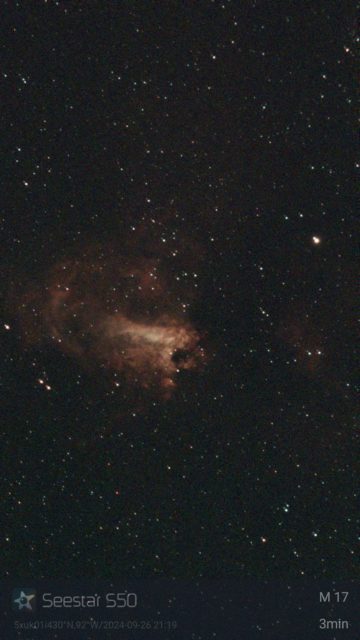
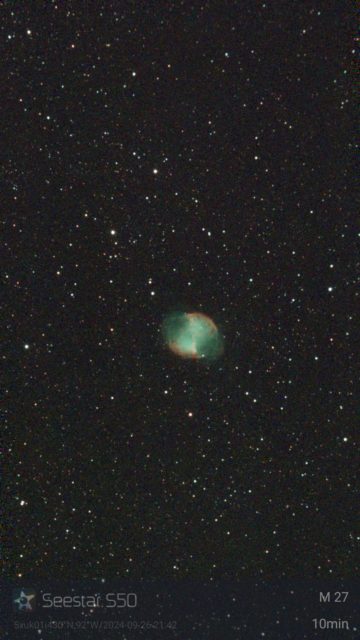
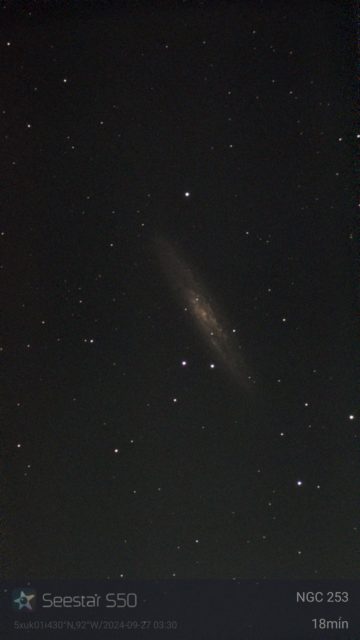
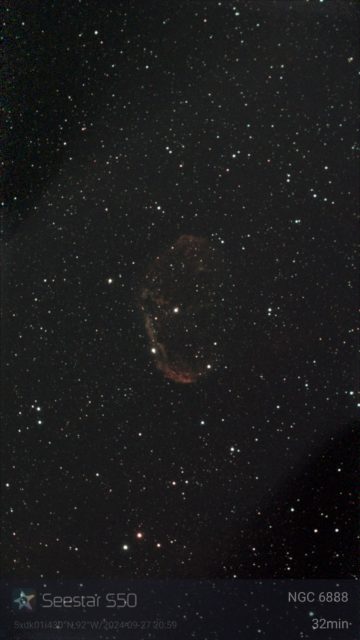
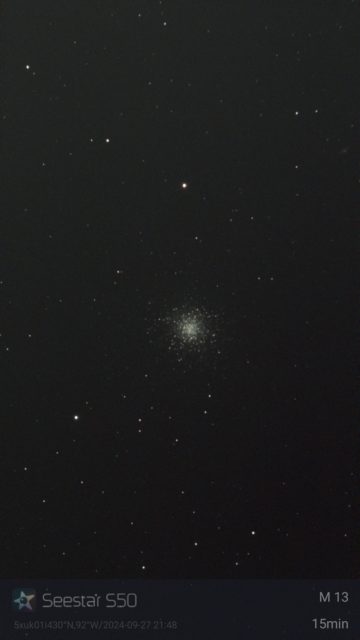
After waiting a while for the tech to mature, I decided that a Smart Telescope would be fun to play with. So, I got the cheapest one on the market.
ZWO built it originally and they spun off a new company called Seestar to market it. In this case, the unit is the Seestar S50, a 50mm triplet in an all-in-one design including mount, camera, computer and storage.
Here’s the first light images from it:
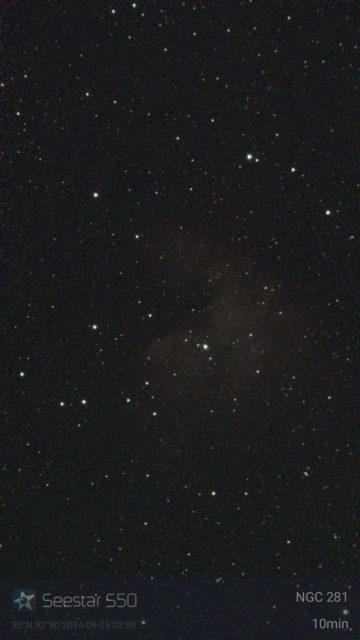

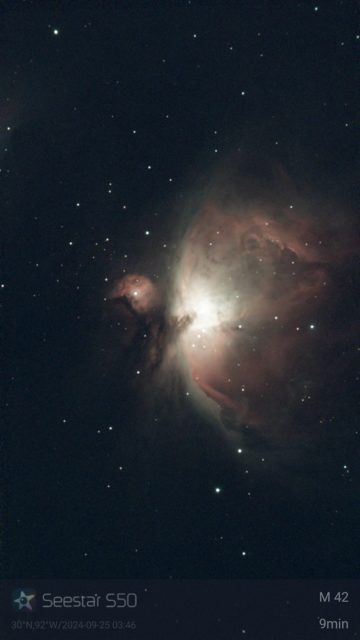
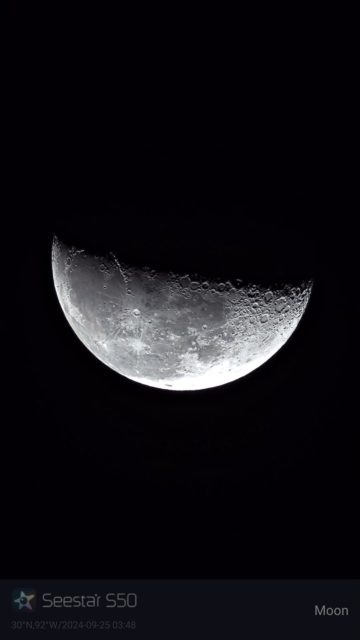

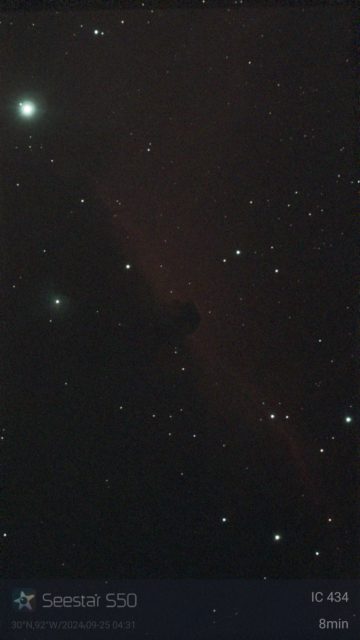


I normally don’t image during a full moon, but the weather was beautiful and I had a new telescope to do more testing with. Plus, there was a comet just begging me to take it’s picture. I couldn’t pass up the chance.
I ended up taking images both Saturday and Sunday nights. I tried to give lots of time to single objects and not jump around so much, for a change.
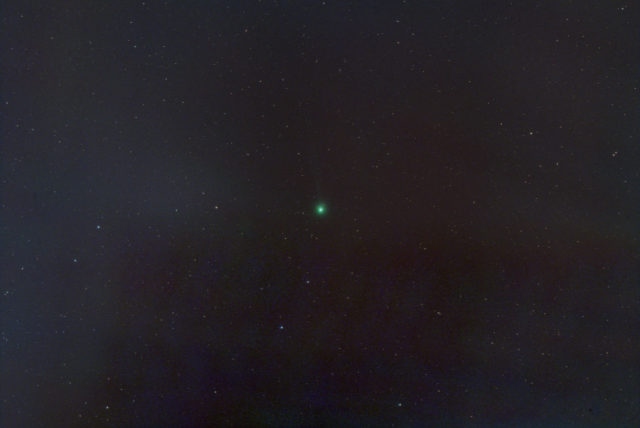
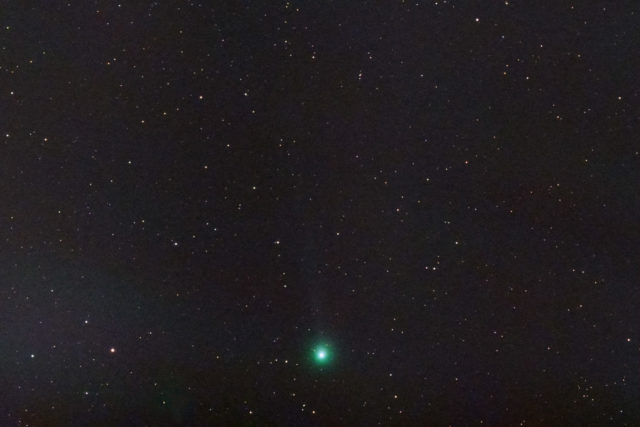

The comet was very low in the west at dusk. I had to quickly get shots and didn’t notice a building’s awning was in the shot along with street lights casting reflections from that direction. Clouds coming and going didn’t help, either.
But! This comet is bright enough to show up (with a tail!) that low in the muck of a Bortle 8-9 zone! That’s quite bright, by most comet imaging standards!

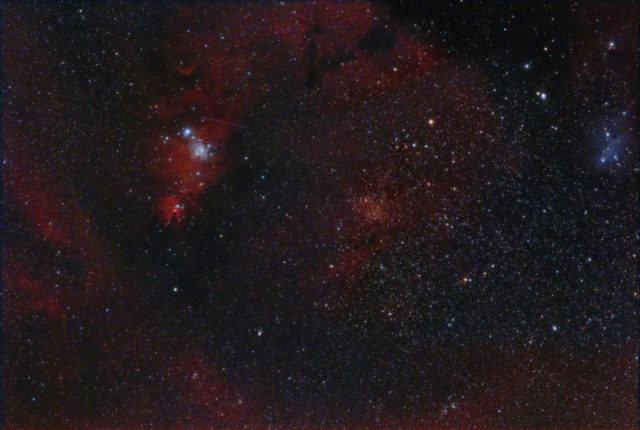
The Cone and the IC 446 Nebula area. It was well placed and I shot 4 hours for IC446 on one night and did a short run on the Cone next door the following night.

I always enjoy seeing M13 again after it emerges in the late winter morning skies high enough to get imagery. The colors got washed out with all the moonlight, unfortunately. I created a darker version with more color enhancement, but the washed out look remains:
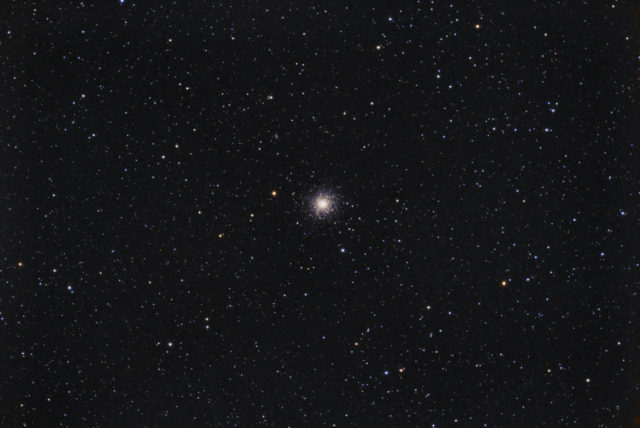
Oh, well… I had fun taking it and processing it. 🙂
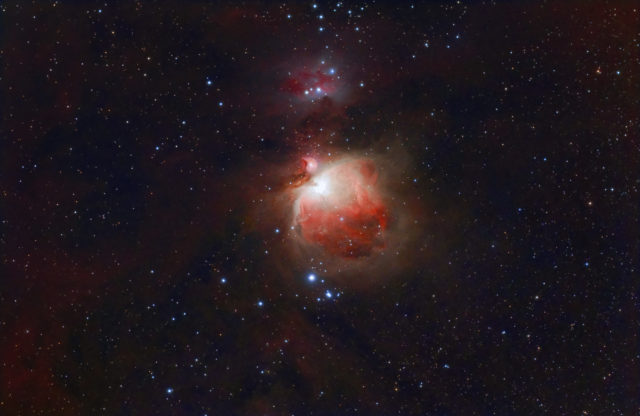
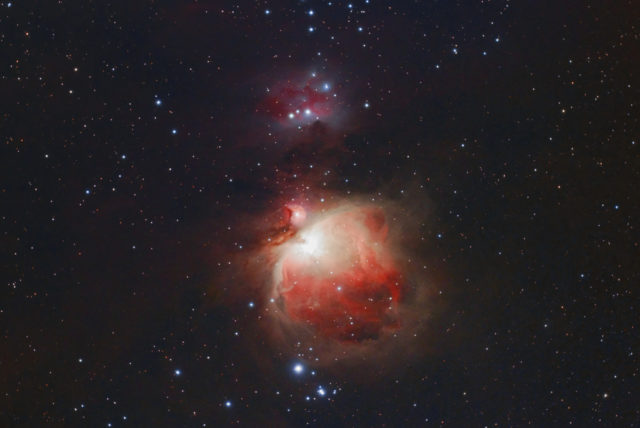
Here’s the very first stacked image taken with my new Astro-Tech AT60EDP. It’s a 60mm, F/5 Petzval telescope with 300mm focal length. This was 64×180 sec using the new scope. Location was a Bortle 8-9 zone with a bright moon out, 48F, clear and above average transparency. The second version is the full field.
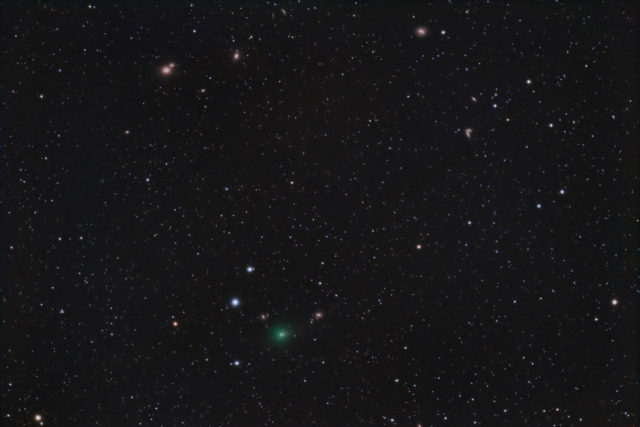
Comet 62P/Tsuchinschan near the galaxies NGC 4608, NGC 4596. Also included are M58, M59, M60 and other faint galaxy fuzzies in the Virgo Galaxy Cluster.
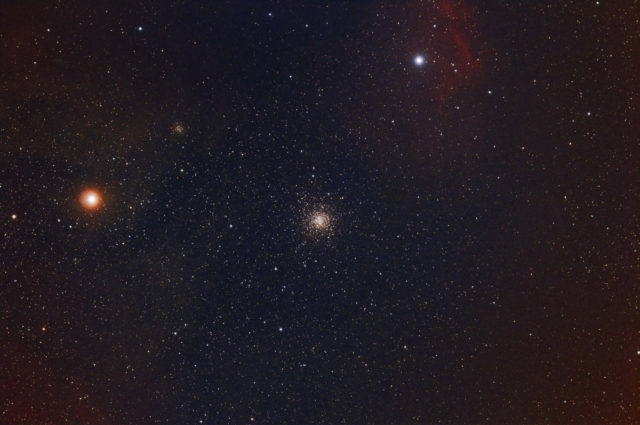
M4 Globular Cluster, Antares and friends in Scorpio. It was still the 1st light night for my new AT60EDP, but at 5:00 AM the next morning. This is 11 x 3 minutes with a QHY294C, Antlia Triband RGB Ultra filter from a Bortle 8-9 zone. Still noisy with only 33 minutes and there was some twilight, but I’m sure I’ll be able to add to it in time.
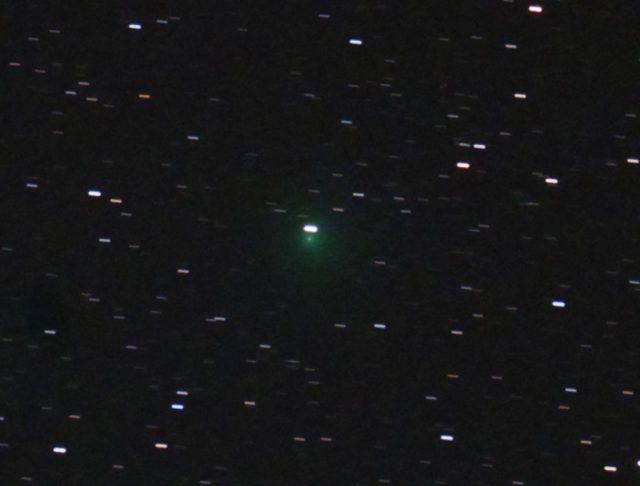

It was a clear Sunday evening on Jan 28th, 2024 and I had to do some tweaking to the scope, so I took advantage of the good weather and did some imaging to test the results.
After the tweaks and adjustments for the scope, I went straight to Comet 144P/Kushida, which was well placed in the early evening sky. I took 45 minutes worth of subs and above are the two images I generated from this data.

I shot of few sub-images of M35 the last time I was out and wanted to return to it now that I tweaked the scope. I got two hours of data on it and it came out reasonably well.
By the time I finished M35, the moon had risen high enough to drown out any dim nebulae and whatnot, so I shot the moon itself. It was still rather low in the sky, but did not come out too bad:
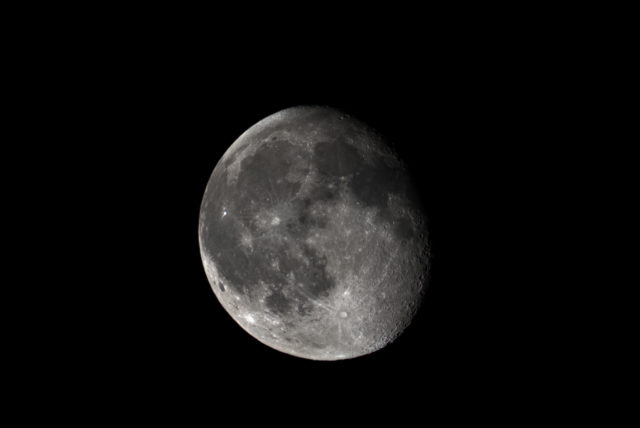
I resized it 200% for this display image and did some sharpening with the AstraImage Maximum Entropy Deconvolution filter in PS. Yes, not too bad at all for a 60mm scope.
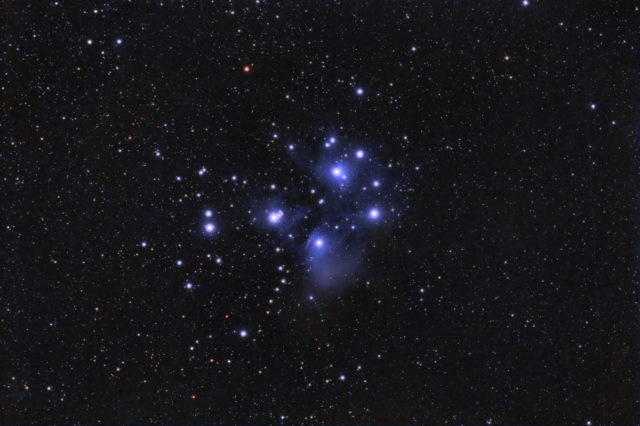
It is a Wednesday in the middle of the week, but the weather is clear and earlier that day I just received my new ZWO tilt-plate adapter. The goal of getting it being to fix my skewed field of view of the AT60ED with the QHY294C camera.
I stuck it on, hooked it to the scope and twisted just one screw up and down a couple of times to see what it would do, then just barely turned it, just a bit and locked it down with the screw beside it. This screw was in line with the landscape orientation of my camera and also the way the field seemed to be tilted.
I crossed my fingers and started shooting 3 minute exposures. It had looked good with 2 sec shots, but I was not convinced until I saw the first normal sub-image.
Amazingly, the field was almost perfectly flat with just a little elongation in one corner! It’s possible the extension tube I removed to put the adapter in place had sagging issues, but I think I just got lucky with the adjustment. Maybe both. lol 🙂
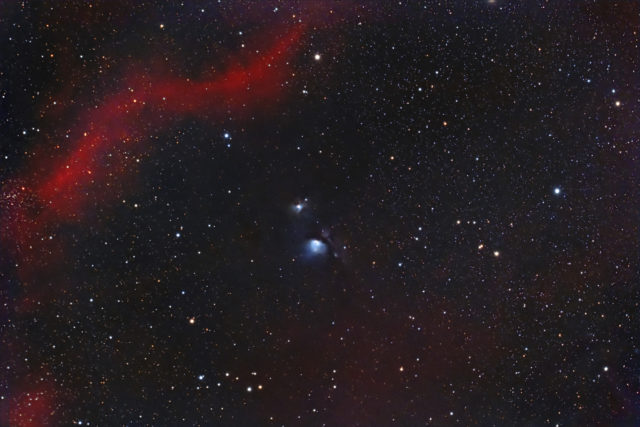
I wasn’t planning on staying out long, since this was supposed to be just a test of the adapter session. I thought I would be adjusting it all evening and not trying to shoot keeper images.
I picked the M78 area, since I had some data from the last session that got cut short by clouds. It needed more time and this was going to be it.
I bagged 47 sub-images and with the 36 from the last session added to it in PS, the image above is the result. The bad parts from the previous session with the worst star elongation were replaced with the new, which was mainly the top left corner.
Finally! Success! I was about to spend more money on a Petzval scope. Glad I waited and tried this first.

It was the last two nights of the year and I had clear weather. What luck!
So, on Friday night, Dec 30th, I had to take care of unfinished business with the Horse Head from the last session. I had something to block the parking lot lights from next door this time. While waiting for the Horse Head to get into position, I took images of M33 (above,) which I hadn’t tried with the AT60ED, yet. It came out decent, I guess.
While taking the Horse Head, I noticed on the charts that a comet was in the field. It was C/2017 K2 (PANSTARRS), at magnitude 11.9 according to Cartes du Ciel.
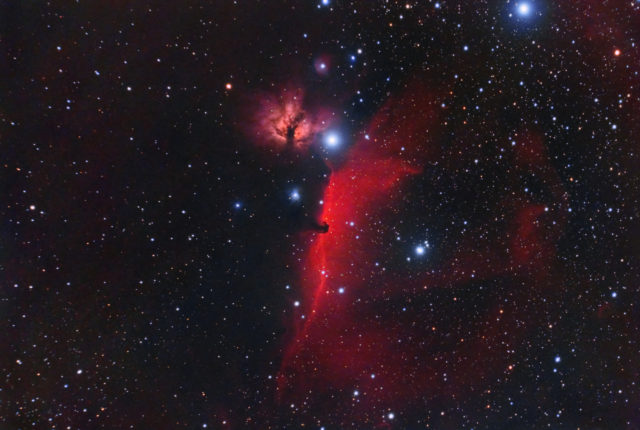
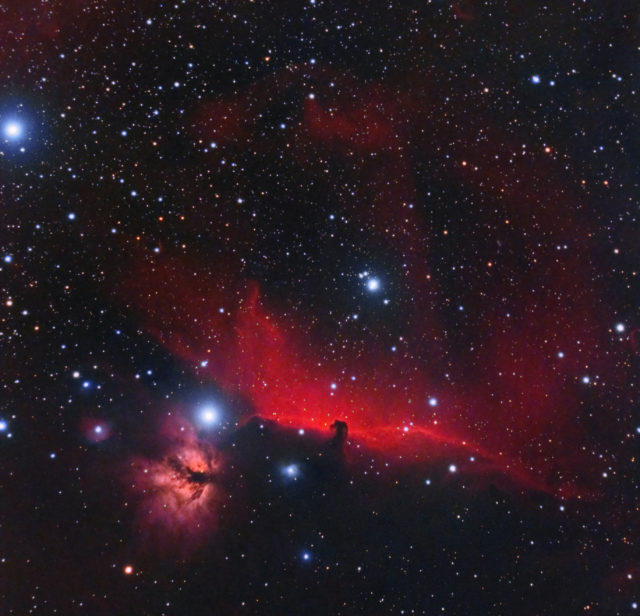
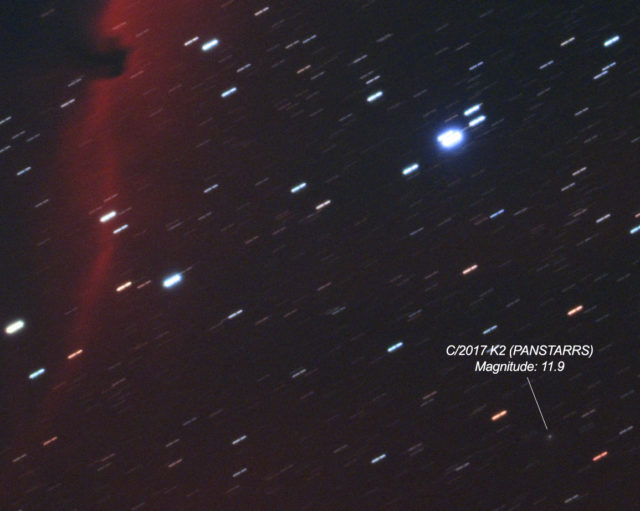
I imaged until almost midnight on Friday. I left the mount setup and brought in the rest with plans to try again on Saturday, New Year’s Eve.
On New Year’s Eve, my plans were to go for M78. While it was getting high enough, I got some more data on the Heart Nebula – an hour and six minutes. I mixed it with the salvaged Heart job from a couple of months back at about 22 percent to help fill in some noise.
When I got going on M78, it gave me problems with tracking. I finally realized it was my guide calibration and after redoing it, I was back in business, but wasted almost an hour figuring that out. Consequently, by the time the clouds came at about 10:20 PM, I still had less than 2 hours of data. Oh, well… I’ll try again next year! lol

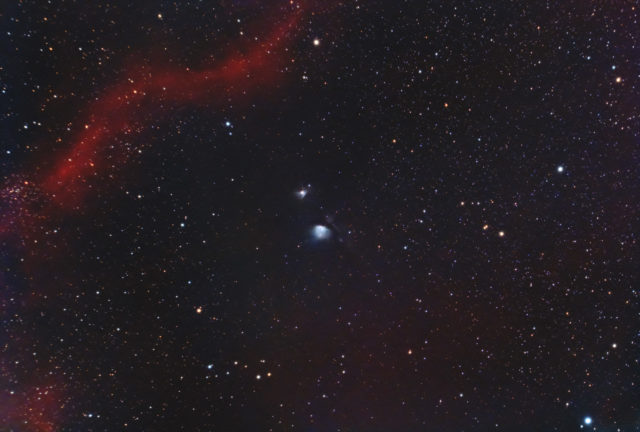
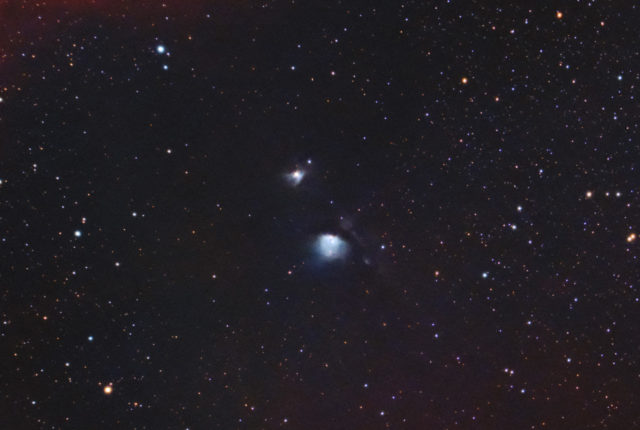

On Wednesday afternoon, Dec 20th, 2023, it was clearer than predicted. So, I broke out the scope and setup to catch the first quarter moon and test a filter I purchased last year that I only used twice.
My main problem with using this filter was getting my flats to work when using the QHY294C camera. I was never really successful last year and I had to manually do flat calibration in FitsWorks, which was a pain. So, my first step was to get a good flat and hope that it worked with the 3 minute exposures I planned to use.
Conditions that evening were predicted to be clear, but only average transparency. In actuality, it was average to below average with a few high clouds that came in periodically. Oh, well… I was not expecting to get any keepers this night, but I still wanted to test that filter.
The Antlia Triband RGB Ultra filter, a lower cost triband filter that I had mixed results with at a dark location last year, was what I wanted to use and test from my heavily light polluted metro area location. It would be the first time to try it in this kind of heavy LP.
So, the first image at the beginning of the post is how the UHC-S filter performed with 9×3 minute subs. The conditions were better when this image was taken, so keep that in mind.
Next, here’s how the Antlia Triband RGB Ultra filter did with roughly the same exposure on a below average night:
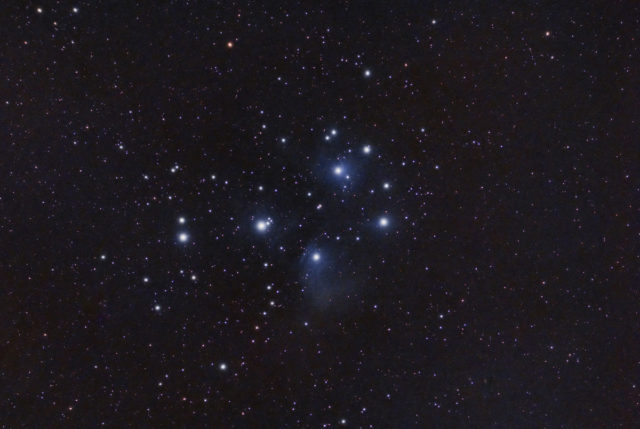
Almost a match for how much nebulosity it picked up, but the key differences are the star halos that the UHC-S filter tends to produce on bright stars and the lack of halos for the Antlia filter, plus the much stronger blue channel with the Triband.
Next, I put it to a real-world test with 50 sub-images of the California Nebula:

I noticed during the acquisition of these that the filter was performing really well, and my flat was working reasonably well. It was not perfect, but good enough for what I intended to accomplish.
I have a second version of the processing using a PS Starless action. Not as clean as a removal as StarNet++, but it’s very fast!
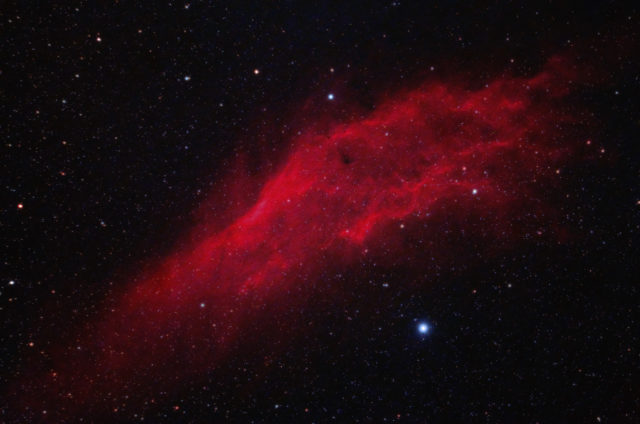
After this, I wanted to try it on the Horse Head and Orion Nebula. I started on the Horse Head, but didn’t get too far because my scope was starting to point directly at the parking lot lighting next door. Once the light was directly hitting the lens, that was it. So, only 4 sub-images were good out of the dozen or so I took.
I opened the stack in FitsWorks while still imaging it and cropped out the bad part that had caught the direct view of the streetlight. I spent only about 5 to 10 minutes fussing with it in FitsWorks, which has very limited image editing tools. It came out much better than I anticipated:
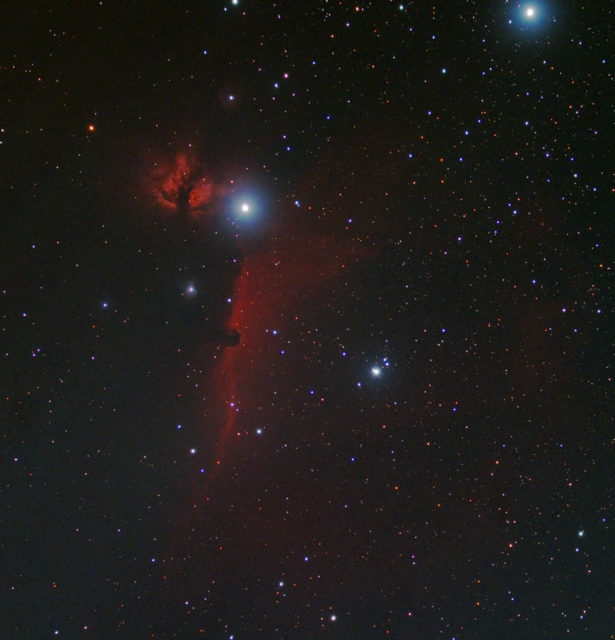
Here’s the same image, but it is the uncropped, full-field. I worked on it in PSCS3 to repair the damage from the streetlight’s strong gradient in the top left corner and do a better processing job than what FitsWorks does:
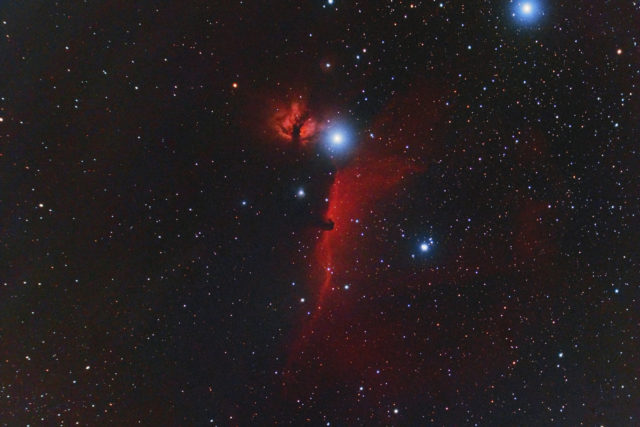
So, my conclusions are this filter, with a good flat, tends to work better in heavy LP than the UHC-S filter. Mainly because it doesn’t produce bad halos around bright stars. But, it is also because it has a great blue channel, unlike the UHC-S. That sure makes color balancing easier and I can go after broadband targets in addition to just nebulae.
BTW, I never did get a shot of the moon that night. The filter test results were too good and I didn’t want to waste any time that I could otherwise use to test it on more nebulae.
The only serious image out the bunch was the Soul Nebula. It was the only one I planned for and was my main target. I managed to get 3.8 hours on it, with .8 hr on one side of the peer and the other 3 hrs on the other. BTW, all images were taken with a QHY294c, a UHC-S filter and a AT60ED on a SkyWatcher GTi goto mount in Bortle 7-8 skies.
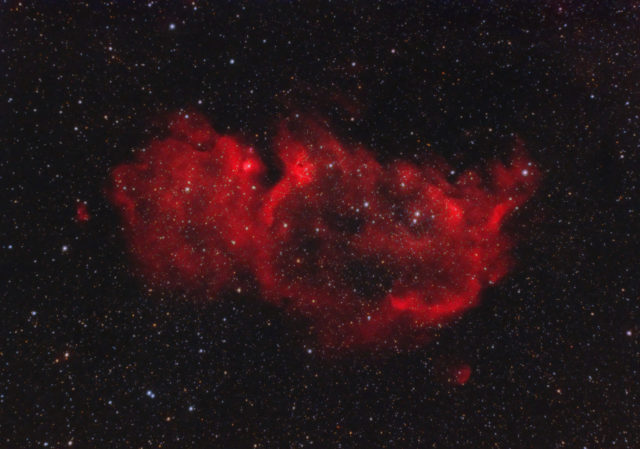
The rest of the images were mostly done with 30 sec exposures at high gain (i.e., 3000. I normally keep it at 1600.) Like I said, I was sightseeing and doing an EAA experiment.
The Elephant’s Trunk Nebula area was the longest of the 30-sec shots, 240 x 30 seconds. I still had to combine it with about 30% blend of a 90 minute exposure taken with another camera, but the same scope. It was still too noisy even after 240 subs.

So, the 30 sec high gain experiment for EAA type imaging is not up to par with what I could do with the QHY183c camera. It did well on open clusters, at least. Oh, well. Live and learn, as they say.

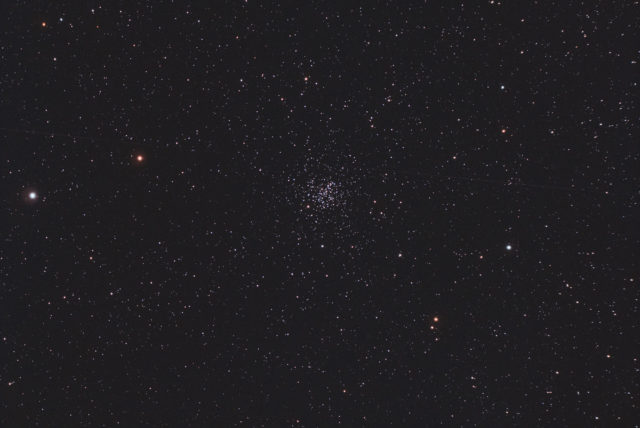
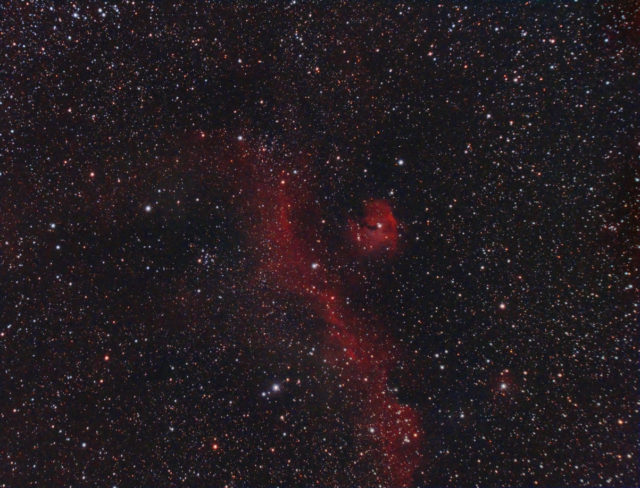

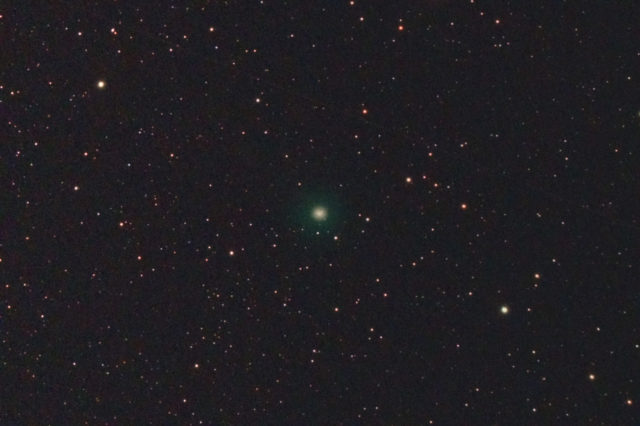
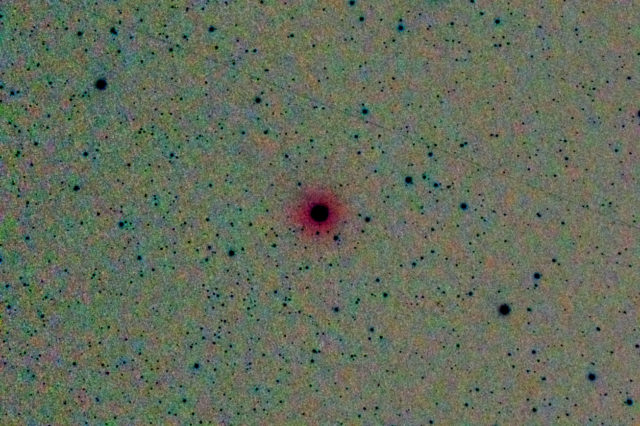
It was the first clear night since the last session on Nov 3rd. I wanted to see this comet and try to get images of the Heart Nebula. The comet was first in line since it was already getting low in the west after sundown. I forgot to adjust the gain down and shot it at the highest gain setting I usually use when focusing and star aligning. Surprisingly, I was able to salvage the sub-images and get a usable image from them. BTW, the comet seems to have a tail, but it could be an artifact of the gain setting or something.
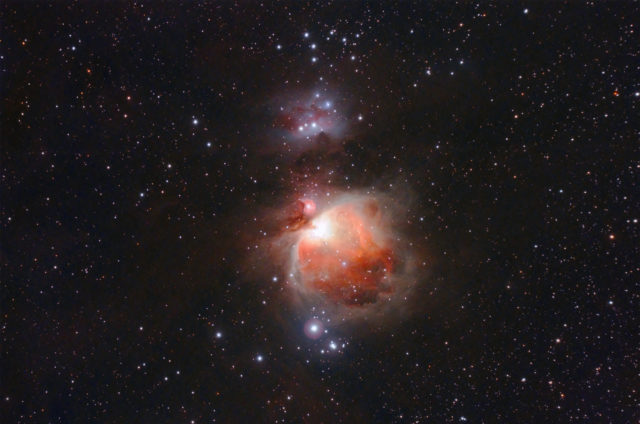

Next up, I did a quick look see at M42 and the M46/M47 Open clusters area. I wasn’t planning on keeping these, but the data on my main target of the night, the Heart Nebula, was horrible. So, I thought better of just ditching these sub-images.
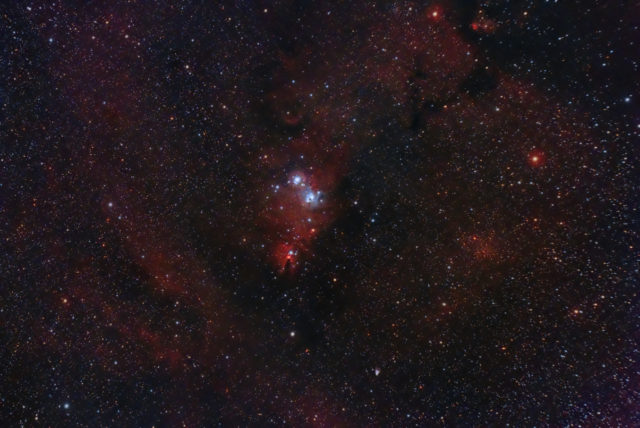


I also did a short run on the Cone Nebula/Christmas Tree Cluster area of 10 x 3 minutes, plus I got a few frames of M78 and M44. The Cone area is not too bad considering it is only 30 minutes of time. M44 was a very quick look and I just wanted to see how it would fit with this rig I was using. But, M78 needs a couple of hours to even begin to look nice and I only got 21 minutes worth. Oh, well… next time.
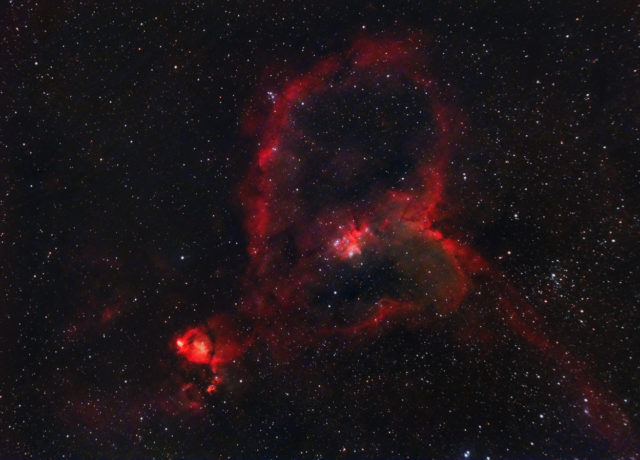
And, finally, here is the salvage job on the Heart Nebula, of which I had two sets of data. One was slightly out of focus, the other had a terrible gradient from an IR source that was pointed right at the lens and I think some of it got through the UHC-S filter, or it was a reflection off the front glass.
What I ended up doing is taking the slightly out of focus stars and removing them totally, then taking the good stars from the data that had the bad gradient and combining them. Still noisy and not that great, but reducing it to 33% smoothed it out enough to pass as a display image.
Oh, well. Another reshoot for this one is in order and also for its close neighbor, the Soul Nebula.